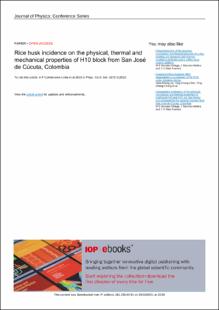Rice husk incidence on the physical, thermal and mechanical properties of H10 block from San José de Cúcuta, Colombia
Artículo de revista
2020-10
Journal of Physics: Conference Series
Reino Unido
The generation of new building materials responds to the reduction of energy consumption and regulation of building interior temperatures as strategy to improve energy efficiency in materials engineering and architecture. This research focuses on the study of the rice husk incidence on the physical, mechanical and thermal properties of H10 block manufactured in the metropolitan area of San José de Cúcuta, Colombia. The methodology consists in 4 stages: In first instance, raw material characterization to identify chemical, structural and morphological components of clay and rice husk. Then, H10 blocks manufacturing in 2 clay mixtures, fired at 900 °C, 1000 °C and 1100 °C. Likewise, tests of manufactured samples to analyze its physical and mechanical properties. Parallel to the manufacturing process, transfer and heat fluxes simulations to evaluate surface temperatures and energy concentration of H10 block. In conclusion, rice husk acts as a technological nutrient added to clay mixture and strengthens thermal and insulating capacity of blocks. Nevertheless, the presence of rice husk in clay mixtures increases water absorption capacity of the products, as the percentage of husk increases. And therefore, the compressive strength decreases, which is a factor to consider for the constructive application of H10 block.
Descripción:
Rice husk incidence on the physical, thermal and mechanical properties of H10 block from San José de Cúcuta, Colombia.pdf
Título: Rice husk incidence on the physical, thermal and mechanical properties of H10 block from San José de Cúcuta, Colombia.pdf
Tamaño: 1.707Mb
 PDF
PDF
 LEER EN FLIP
LEER EN FLIP
Título: Rice husk incidence on the physical, thermal and mechanical properties of H10 block from San José de Cúcuta, Colombia.pdf
Tamaño: 1.707Mb
 PDF
PDF
 LEER EN FLIP
LEER EN FLIP















